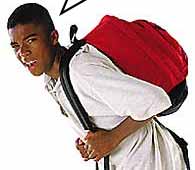

Effect of Backpack Weight on Postural Angles
in Preadolescent ChildrenThis section is compiled by Frank M. Painter, D.C.
Send all comments or additions to: Frankp@chiro.org




FROM: Indian Pediatr. 2010 (Jul 7); 47 (7): 575–580
OPEN ACCESS Ramprasad M, Alias J, Raghuveer AK.
Associate Professor, Movement Analysis Lab,
Srinivas College of Physiotherapy,
Affiliated to Rajiv Gandhi University of Health Sciences Bangalore Pandeswara,
Mangalore, Karnataka, 575001, India.Background: Carrying heavy backpacks could cause a wide spectrum of pain related musculoskeletal disorders and postural dysfunctions.
Objective: To determine the changes in various postural angles with different backpack weights in preadolescent children.
Design: Cross-sectional. Participants: Healthy male school-children (n=200), mean (SD) age: 12.5 (0.5) years, from high schools in Mangalore, India.
Measurements: Bodyweight and height were measured using a forceplate and stadiometer, respectively. From the weight recorded, 5%, 10%, 15%, 20%, and 25% of the bodyweight were calculated and implemented as their respective backpack loads. The Image Tool version 3.0, digitizing software was used for analyzing photographs to determine craniovertebral (CV), head on neck (HON), head and neck on trunk (HNOT), trunk and lower limb angles. Postural angles were compared with no backpack and with backpacks weighing 5% to 25% of the subjects bodyweight.
Results: The CV angle changed significantly after 15% of backpack load (P < 0.05). The HON and HNOT angles changed significantly after 10% of backpack load (P < 0.05). The trunk and lower limb angle also changed significantly after 5%; of backpack load (P < 0.05).
Conclusions: Carrying a backpack weighing 15% of body weight changes all the postural angles in preadolescent children.

Return to BACKPACKS
Since 01-25-2010


| Home Page | Visit Our Sponsors | Become a Sponsor |
Please read our DISCLAIMER |
